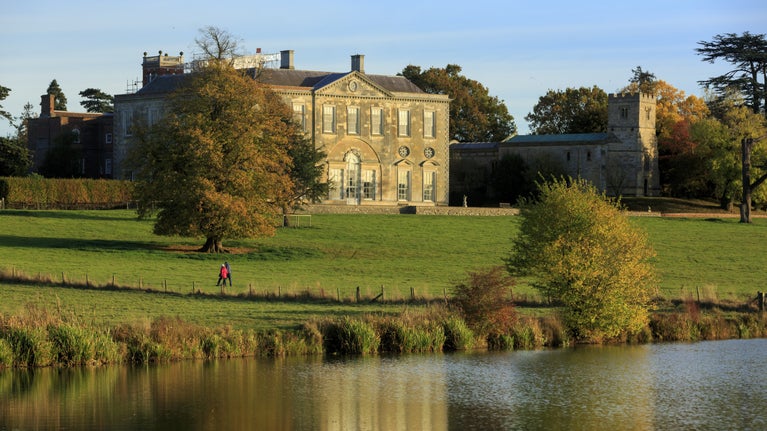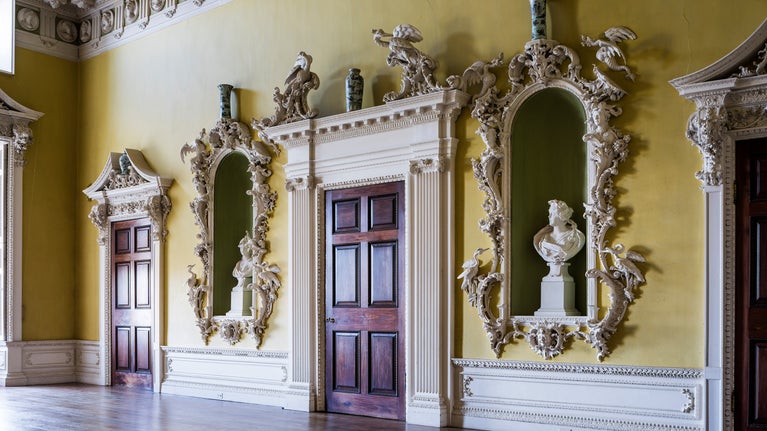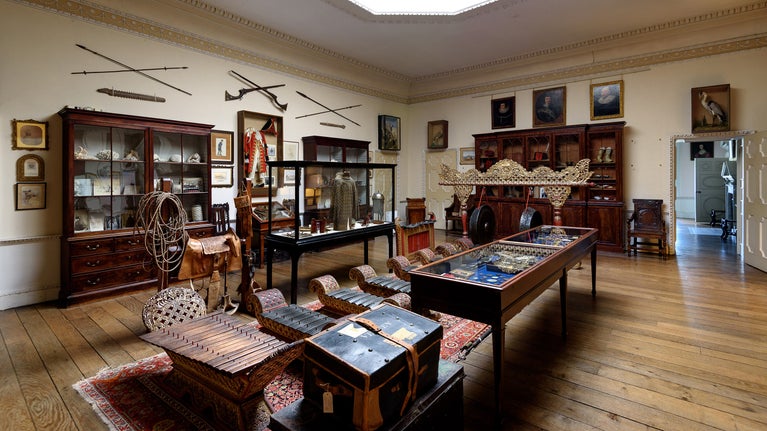
Discover more at Claydon
Find out when Claydon is open, how to get here, the things to see and do and more.

Claydon House, Buckinghamshire has been home to the Verney family since 1620. The family suffered during the English Civil War but later rebuilt their wealth through trade and marriage. In the 18th century, Ralph, 2nd Earl Verney commissioned a grand, unfinished mansion but lost his large fortune through poor investment and political ambition. The home you see today was created in the 19th century from the remains of that house.
There has been a settlement at Claydon for over 1000 years. Domesday Book of 1086 records that (Middle) Claydon had a population of 21 households. Nestled close to Claydon House is the Church of All Saints which dates from the 13th century. Sir Ralph Verney (d. 1478), a London Merchant, purchased the manor of Claydon in c.1463. He leased Claydon to relative Roger Giffard, whose family built the first house on this site.
In 1620 Sir Edmund Verney (1590–1642), courtier and politician, made Claydon the principal family estate. The Verneys had divided loyalties during the English Civil War (1642–51). Sir Edmund supported the Royalist cause and in 1642 was appointed Bearer of the King’s Standard. He died at the Battle of Edge Hill (1642) whilst refusing to surrender the Standard to the Roundheads.
Despite supporting the Parliamentarian cause, his eldest son, Sir Ralph (1613–96) did not prosper during the Commonwealth. He had become disillusioned with religious and political radicalism and in 1643 refused to sign the solemn league and covenant with its focus on religious reform. Shortly after, he undertook a self-imposed exile in France and the family estates were confiscated. Following the Restoration of Charles II to the throne in 1660, Ralph was made a Baronet, and the family prospects improved.
Sir John Verney (1640–1717), 1st Viscount Fermanagh, inherited Claydon in 1696. As a successful London Merchant he greatly improved the family fortunes through his involvement with the Levant, Royal Africa and East India Companies. He was a Governor of the Royal Africa Company, owned shares and was involved with the petitioning to Charles II and Parliament for an Africa Company Charter.
By the 1680s, through Sir John’s connections with the Royal Africa Company, there was at least one enslaved person, Peregrine Tyam (died around 1707), within the Verney household. The National Trust, in collaboration with the Verney Estate, is actively researching the Verney family’s involvement with the trade of enslaved people.
In 1752, Ralph, 2nd Earl Verney (1712–91) inherited the substantial Verney estates. Between 1757–71, he undertook an ambitious and extravagant building project, wanting to rival his neighbours at Stowe. Although unfinished, the vision included a great central domed rotunda for the entrance hall. On either side were extensive wings: one containing a vast ballroom and the other, the state rooms.

Claydon contains some of the finest Rococo decorative interiors in England. The principal designer was Luke Lightfoot, a talented London stonemason and woodcarver. He provided the elaborate internal decoration, including the exuberant painted wooden carvings in the North Hall and the Chinese Room tea pavilion.
From 1768 the architect Sir Thomas Robinson managed the work. Robinson appointed Joseph Rose to execute the plasterwork and the Saloon and Staircase Hall are models of Neo-classical restraint.
The 2nd Earl employed James Sanderson to lay out the park surrounding the house in the fashionable landscape style of Lancelot ‘Capability’ Brown.
The 2nd Earl’s extravagant aspirations for Claydon were never realised. He had invested in East India Company stock and speculative ventures, including the purchase of West Indian lands. He provided loans to Jamaican plantation owners but had been forced to sue for unpaid debts and was declared bankrupt in the 1780s. The new house remained unfinished, and the contents were sold at auction. The Earl died penniless in 1791.
When Mary, Baroness Fermanagh (1737–10) inherited Claydon from her uncle she also inherited huge debts and an unstable and incomplete house. Her solution to clear these debts was to sell land and, to reduce costs, dismantle the Rotunda and Ballroom and sell the building materials.
The reduction of two-thirds of the house gives Claydon its unique charm. The west wing with its grand estate rooms became the main house, explains why the decoration in several rooms is unfinished and why there is no main entrance.
Baroness Fermanagh also inherited the outstanding debts relating to loans and investments made by the 2nd Earl. This included suing for debts on mortgages and money leant to the owner of at least one Jamaican plantation.

Sir Harry Verney, 2nd Baronet (1801–94) inherited Claydon in 1826. Following his marriage to Parthenope Nightingale (d. 1890) in 1858, Claydon was repaired, modernised and refurbished to make it ‘more agreeable and convenient to live in’. Much of Claydon today reflects their ownership and use of Claydon as a family home.
Parthenope’s sister Florence (1820–1910) was a frequent guest at Claydon. The founder of modern nursing, Florence was also a pioneering figure in reforming army medical services. She campaigned with Sir Harry as MP for Buckinghamshire to advocate for these reforms. Memorabilia from Florence’s time in Crimea can be seen in the house along with her suite of rooms.
In 1893, Sir Harry created a museum room to house the family’s growing collection of global artefacts. Originally one of the most impressive Victorian family collections of its kind, it included items collected by Sir Harry Verney in South America and by Sir Edmund Hope Verney, 3rd Baronet from north-west Canada, Africa and India. These were displayed alongside family memorabilia, souvenirs and militaria. The current collection is a fragment of the original, following sales in the early 20th century.

In 1956, Sir Ralph Verney, 5th Baronet (1915–2001) gave the house to the National Trust. The house was restored, and interior decorator John Fowler (1906–77) advised on the redecoration of the state rooms.
Until 2019 the Verney family kept an apartment in the East Wing. The Verney family still own and run the Claydon Estate and Courtyard.
The display of Claydon’s internationally significant collection of historic clothing is changed annually due to the fragile nature of the pieces. This collection contains items of dress from the 17th to the 19th centuries and provides a glimpse into the lives of the people who wore them.
Work to restore the garden continues, and the Gothic-style fernery has recently been replanted. Visitors can enjoy sweeping views across the historic parkland from the west terrace and south lawn. The upper terrace, with its more formal planting, includes seasonal and pollinator friendly plants to ensure year-round interest.
Verney, M. M., and H. C. G. Matthew. ‘Verney [formerly Calvert], Sir Harry, second baronet (1801–1894), politician.’ Oxford Dictionary of National Biography.
Whyman, Susan E. ‘Verney, Sir Edmund (1590–1642), courtier and politician.’ Oxford Dictionary of National Biography.
Woodland, Patrick. ‘Verney, Ralph, second Earl Verney (1714–1791), politician.’ Oxford Dictionary of National Biography.
Profile & Legacies Summary for: Ralph Verney 2nd Earl Verney 1714 - 1791, Summary of Individual | Legacies of British Slavery

Find out when Claydon is open, how to get here, the things to see and do and more.
Discover sumptuous interiors, explore the grounds, step back in time or go on an adventure – there’s so much to see and do on a visit to Claydon.

See history brought to life at Claydon House: sumptuous craftsmanship in 18th-century interiors, displays of historic costume – and a connection to Florence Nightingale.

Learn about people from the past, discover remarkable works of art and brush up on your knowledge of architecture and gardens.

From landscape gardeners to LGBTQ+ campaigners and suffragettes to famous writers, many people have had their impact on the places we care for. Discover their stories and the lasting legacies they’ve left behind.
